The Montagne Noire
 The Montagne Noire could have been a small country, a bit like Luxemburg. It has its own history and takes up its own place in the Languedoc. Not much is known about this beautiful woodland mountain range. Here and there we stumble upon a small piece of text in French, which enables us to expand our collection of data. Yes, it's still possible to find a bit of pure nature, where historic remains are silent witnesses of a turbulent past, where time seems to stand still, or at least goes very slow. And better still, to walk around for hours without meeting anyone.
The Montagne Noire could have been a small country, a bit like Luxemburg. It has its own history and takes up its own place in the Languedoc. Not much is known about this beautiful woodland mountain range. Here and there we stumble upon a small piece of text in French, which enables us to expand our collection of data. Yes, it's still possible to find a bit of pure nature, where historic remains are silent witnesses of a turbulent past, where time seems to stand still, or at least goes very slow. And better still, to walk around for hours without meeting anyone.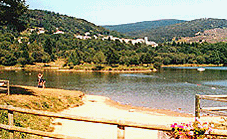 There are so many different walks, too much for one holiday only. A very good map is the IGN-map 2344E of the Série Bleu (Mazamet). It is important to carry a compass, water, some food and tissues, and wear good walking shoes, a hat or cap and perhaps even carry a good walking stick. This is rough nature. There are no McDonald's, or toilets or even benches. These walks go over ancient paths, perhaps even millennia old, because also in prehistory, men travelled on these paths through the mountains.
There are so many different walks, too much for one holiday only. A very good map is the IGN-map 2344E of the Série Bleu (Mazamet). It is important to carry a compass, water, some food and tissues, and wear good walking shoes, a hat or cap and perhaps even carry a good walking stick. This is rough nature. There are no McDonald's, or toilets or even benches. These walks go over ancient paths, perhaps even millennia old, because also in prehistory, men travelled on these paths through the mountains.Apart from nature, also history is an important goal for many people's holiday. And apart from nature and history, the mountains also have several beautiful lakes offering refreshment on a hot day. One of these lakes is Lac Birotos in Pradelles-Cabardès, with a nice little beach and clear water.
The history of the Montagne Noire
The earliest traces of human presence in the Montagne Noire are from the Stone Age. The mountain range offered shelter in its many caves. Rivers and sources provided them with fresh water. The woods were full with animals and many pieces of land were fertile for later agriculture. Remains of the Celts are still omnipresent in the form of dolmens and Menhirs. Dolmens are tombs, covered with a large stone. Menhirs are standing stones. These words are Celtic. Menhirs and obelisks mark important places, or were tools to read the position of the sun and the stars and also the seasons. They may have been used the same way as the Egyptians used their obelisks.
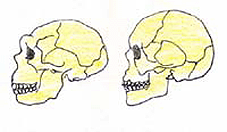 On the right you can see two skulls of prehistoric man. The first one is from the early Stone Age, about 200.000 years ago (the Homo Sapiens Neanderthalensis) and the second skull is from the new Stone Age, about 40.000 years ago (Homo Sapiens Sapiens). The latter showed up seemingly from nowhere and introduced a whole different lifestyle and culture. Anthropologists are still speculating about their origin.
On the right you can see two skulls of prehistoric man. The first one is from the early Stone Age, about 200.000 years ago (the Homo Sapiens Neanderthalensis) and the second skull is from the new Stone Age, about 40.000 years ago (Homo Sapiens Sapiens). The latter showed up seemingly from nowhere and introduced a whole different lifestyle and culture. Anthropologists are still speculating about their origin.In this period, the cult of the bear was popular. People thought that the power of the bear would enter the person who was wearing the skin and a chain of teeth from the bear (usually the one who killed the bear). The leader of the group was often called The Bear. In Celtic this would be Arth Ur. It is obvious that this title would stick around for quite a while. Also a hero from the Languedoc was called Bera. The companion of Artemis was a bear and the two star systems Little Bear and Great Bear are named in this era (Ursus).
The history of the Villeneuvois
Villeneuve-Minervois lies at the foot of the mountains and is also called the Gate of the Montagne Noire. There are several restaurants, a bakery, a butcher's and a garage. There is also an ATM just in case you need to withdraw money. Near its chateau you can buy some great wines. Close to Villeneuve you find several Celtic remains. This little town is very old and there are a few known facts about its history. Prehistoric man lived on the silted terraces of the river Clamoux, just above the mill (Moulin) on the road to Cabrespine and in St. Andrieu. We are now 35.000 years back in time. The caves in the area are inhabited for many, many centuries. Especially the ones in Cauna de Vegues revealed archaeological remains dating from this period.
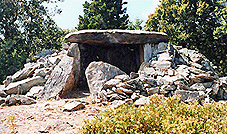 The Dolmens of Villeneuve
The Dolmens of VilleneuveFrom Villeneuve a narrow road leads to the at least 5000 year old dolmen "Palet de Roland". The town has created an access road on its own initiative, so that the ancient monuments can be accessible for all. In 1972, the monument was restored by a team of amateur archaeologists. It was already very well preserved. Human remains have been found, along with pieces of flint stone. Vanuit Villeneuve loopt een weg naar de 5000 jaar oude dolmen 'Palet de Roland'. Het dorp heeft de weg op eigen initiatief laten aanleggen, zodat de overblijfselen uit de oudheid voor iedereen toegankelijk zijn. In 1972 werd het bouwwerk door een team amateur-archeologen gerestaureerd. De dolmen is zo goed bewaard gebleven, dat men zich de originele staat goed kan voorstellen. Men heeft er menselijke overblijfselen gevonden, evenals splinters van vuurstenen.
Close to the dolmen lies the Tombe de Roland, a strange, incomplete tomb with a deep trench. Recent investigations discovered a piece of marble from the 17th century. It was probably a tomb, used for more people throughout the ages, from the 3rd century onwards. The burial gifts found on this spot include bronze and copper armlets and earthenware, which belong to these type of monuments. The top of the tomb is lost, so you can only see it's entrance and the burial chamber. The megalith is dominated by the remains of the farm with the same name. It looks as if the tomb, which was built millennia ago, was not built to be a tomb. It may just have been the remains of a rock from which an obelisk was cut out. The name given to the dolmens originate from a legend. Roland, the cousin of Charlemagne (9th century) would have worked on a sunstone, which he put on top of another stone. It was his wish to be buried close to this place. There are two walks to the monuments and there are information boards at the parking place.
The Roman Era
An aerial photograph shows that Villeneuve and the Clamoux formed the north-eastern and eastern border of the Roman province of Narbonensis, which was founded in 118 B.C. At a later date, the border of the Roman city of Carcasso (27 B.C.) was laid over the old one. Then, a Roman road was constructed between Bezièrs and Toulouse, which did not pass Carcassonne, it passed Villeneuve on its south end and crossed the Clamoux at Gadhoms. This road became known as the Chemin de Lestrade.
Remains of habitation, whether it was agriculture or trade, as well as old Roman bridges, can be found all over the Montagne Noire. At Gadhoms we find remains from the 1st century B.C., especially where the old castle once stood. At St. Andrieu and at La Vigne we find remains from the second half of the 1st century A.D. At Clapiès, near D'Escapat, we find a cemetery of a later date. At Villeneuve the Roman remains were integrated in the houses built during the reign of Charlemagne (9th century) and very difficult to recognize today.
The Middle Ages
 DDuring the reign of the Visigoths, the Montagne Noire was the borderland between the Visigoth territories and the land of the Franks. The Montagne Noire is dotted with ruins and small villages which date back to Visigoth times, such as Hautpoul. This borderland was heavily protected.
DDuring the reign of the Visigoths, the Montagne Noire was the borderland between the Visigoth territories and the land of the Franks. The Montagne Noire is dotted with ruins and small villages which date back to Visigoth times, such as Hautpoul. This borderland was heavily protected.The earliest name of Villeneuve was St. Mamet. In 890 and 942, it was an annex of the abbey of St. Hilaire le Grand of Potiers. During the reigns of Pepin I and II (8th century), Villeneuve was situated at the very border of the kingdom of Aquitaine, of which Potiers was the Capital. Queen Radegonde brought back relics of Saint Mamet on her way back from Turkey, which she gave to Potiers. This explains the name of St. Mamet.
In 1103 the small settlement called Villenouvette (Villata) with the churches St. Etienne de Clamos and St. Andre du Villar, belonged to the abbey of St. Chinian. The settlement was probably founded by the relatively unknown abbey of St. Estève de Cabardès from Mas-Cabardès. The church, which was built on the remains of the old monastery, undoubtedly received the relics of the patron saint of the abbey, St. Etienne.
The Cathars
During the Albigenzian Crusade, a knight was taken prisoner at Villeneuve by Simon de Montfort's men. This violent act resulted in a town's meeting where it was agreed upon that the town of Villeneuve would be given to Isarn d'Aragon, canon and bishop of Carcassonne, abbot of Montolieu and prior of Alaigne. This would ensure protection against future violence. To be able to defend the town, a fortress was built in 1212. Parts of which are still to be seen in the present castle. The Romanesque additions are of a later date. In the following period, Villeneuvois (the town and its surroundings) were accused three times of heresy. The name of the town appears in the records of the Inquisition of the Dominican Order at Carcassonne. The priest of Villeneuve and his cousin were looking for a compromise. Another accusation was the cause of a trial in Rome. It is well known that many Cathars fled to the Montagne Noire.
Chateau de Cabrespine
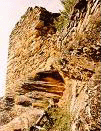 High above the road at Cabrespine in the Montagne Noire, lie the remains of a castle. Not much is left of the building and visiting it is at one's own risk, but we do know that during the Albigenzian crusade it was the subject of a trial between Simon de Montfort and Guillaume, the abbot of Lagrasse. The leader of the crusade had gained possession of the town and castle of Cabrespine, just as he gained possession of all the other towns and castles he had conquered. Judge Thédise, however, returned the town and its castle to the abbot and compensated de Montfort in a different manner in 1215.
High above the road at Cabrespine in the Montagne Noire, lie the remains of a castle. Not much is left of the building and visiting it is at one's own risk, but we do know that during the Albigenzian crusade it was the subject of a trial between Simon de Montfort and Guillaume, the abbot of Lagrasse. The leader of the crusade had gained possession of the town and castle of Cabrespine, just as he gained possession of all the other towns and castles he had conquered. Judge Thédise, however, returned the town and its castle to the abbot and compensated de Montfort in a different manner in 1215. It may have been due to the importance of the castles of Lastours, but Cabrespine hardly leaves us any other facts. It's own history, important or not, may have been forgotten in time.
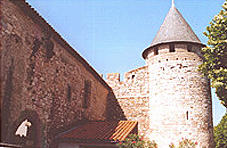 The community of Villeneuve enriched itself by making new purchases. Especially the lands of the Cathar people who had fled their properties or found death on the stake, were now readily available. The population grew. The Lord of Villeneuve made several agreements with the inhabitants.
The community of Villeneuve enriched itself by making new purchases. Especially the lands of the Cathar people who had fled their properties or found death on the stake, were now readily available. The population grew. The Lord of Villeneuve made several agreements with the inhabitants. The 100 year war and the plague epidemic have left little of the old castle, although the boulevards in Villeneuve still show its borders. The small hamlets of Le Viala and St. Mamet were eventually abandoned. Between 1450 and 1560, prosperity returned. The castle was extended with a northern part with spiral stairs. The large tower was given several pieces of artillery in 1550. During the Religious Wars, the village and castle were taken by the Huguenots under the command of captain Fournier, who remained here for several months.
The development of the vine culture
When peace returned to Villeneuve-Minervois, its inhabitants took to agriculture (grain, olives) and sheep farming. In this period there was little vine culture. The end of the reign of Louis XIV and the beginning of the reign of Louis XV was a difficult period for the area. Many people left. This resulted in the opening up of large pieces of land for vine culture. This new market became important for the development of transport and the roads were much improved.
From 1750, vine culture around Villeneuve became more and more important. The prosperity of the town was largely due to the wine. In the beginning the crop was used for distillation (strong liquor). While most of the Languedoc suffered from the devastation of the crops by the Xilophera lice, the area around Villeneuve was only damaged lightly. As wine was extra expensive in this period, Villeneuve became a wealthy town. The worst year was 1907. This resulted in the foundation of the Cooperative Cave, to aid the small wine farmer. Slowly but surely all farmers joined the Coop. Today, many wine estates carry the name "Appellation Minervois" (AOC). Important parts of the area have been replanted to ensure the 'appellation'. There is also a fusion between the Coops of Villeneuve and Laure-Minervois.
The Second World War
After the invasion of the until that moment free parts of southern France, a resistance group arose, called the Maquis. They worked first from La Plaine in Bagnoles and then in the cave at Trassanel. Finally, they went to the Montredon farm in Fournes. After the German parachutes landed at St. Martin, the Battle of Trassanel took place. The Germans won the battle and marched on to Les Ilhes, Roquefere and Pradelles. About 42 members of the Maquis were killed in their attempt to defend their homeland and their families, among who were also 16 year old boys. WWII has left deep wounds in the hearts of the people of the Montagne Noire. Monuments remind us of the tragic events of 1944.
 Tourism
TourismAfter the Second World War, the people of the Montagne Noire picked up the pieces and tried to start a new life. Tourism discovered its beauty and history and during the hot summer months, people go up into the mountains for its pure fresh air and spend their weekends or holidays at one of the lakes, which ensure wonderful refreshment.
Note of the author:
All of us have to work on our environment, if you do visit the Montagne Noire, please take your litter with you. Thank you!
Journeys through the Montagne Noire
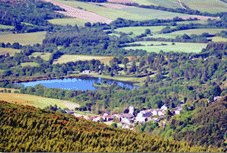 Pradelles-Cabardès
Pradelles-CabardèsPradelles-Cabardés is a small town, situated on a hilly plateau, about 850 km above sealevel. This town is dominated by the highest top of the Montagne Noire, the Pic de Nore (1211 m). In the 13th century, the village was specialized in the storage of ice balls for the towns in the valleys below. In Summer, the ice was used for the preservation of meat. The many inns relied on the ice from Pradelles. This made the town very prosperous.
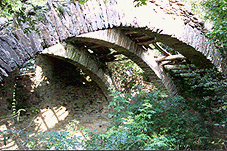 The first ice pits were holes in the ground, covered by a stone construction to keep the ice from melting in the sun. In the course of the centuries the demand for ice grew and grew. In 1902 there were no less than 14 ice pits (glacières) and the ice balls, which would weigh up to 50 kilograms, were pulled out of the pits by horse-sledges and transported at night to Carcassonne, Mazamet, Narbonne and Sète. In 1905 the record showed a sale of 30.000 ice balls! Pradelles became the richest town in the Montagne Noire.
The first ice pits were holes in the ground, covered by a stone construction to keep the ice from melting in the sun. In the course of the centuries the demand for ice grew and grew. In 1902 there were no less than 14 ice pits (glacières) and the ice balls, which would weigh up to 50 kilograms, were pulled out of the pits by horse-sledges and transported at night to Carcassonne, Mazamet, Narbonne and Sète. In 1905 the record showed a sale of 30.000 ice balls! Pradelles became the richest town in the Montagne Noire.However, after the invention of the refrigerator in the 20th century, the ice industry collapsed and many inhabitants of Pradelles-Cabardès moved to the big cities. Today, Pradelles is a quiet village near a lake, visited by tourists for its clean fresh mountain air and beautiful nature walks. The yellow tour brings you to the remains of the glacières and if you like, even to the top of the Pic de Nore.
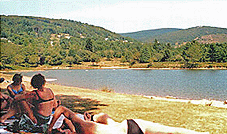 The name Cabardès originated from Cabaret, the name of the main castle of Lastours. Pradelles means 'little prairie'. The Lake of Pradelles, also called Lac Birotos, is a wonderful place to sit or have a refreshing swim. In Summer months you can sit on a small terrace by the lakeside and enjoy an ice cream or a cool drink.
The name Cabardès originated from Cabaret, the name of the main castle of Lastours. Pradelles means 'little prairie'. The Lake of Pradelles, also called Lac Birotos, is a wonderful place to sit or have a refreshing swim. In Summer months you can sit on a small terrace by the lakeside and enjoy an ice cream or a cool drink.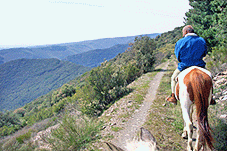 On the other side of Pradelles lies a western farm from where you can take daytrips on horseback. Some experience is a 'must', because you will go into nature. The paths go through the woodland, through a river or a steep bend with a backdrop. Some parts will go in trot.
On the other side of Pradelles lies a western farm from where you can take daytrips on horseback. Some experience is a 'must', because you will go into nature. The paths go through the woodland, through a river or a steep bend with a backdrop. Some parts will go in trot. There are 1, 2 and 3 hour journeys, daytrips and trips for more than one day. The riding is based on western style (usually with a knob on the saddle) and they use for instance appaloosa's and quarter horses which are a little smaller and therefore much better equipped for mountainous rides. Riding through nature is a wonderful, adventurous experience.
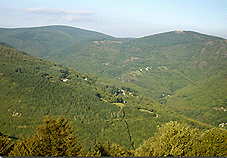 Castans
CastansCastans is the name given to the communion which exists of seven villages: Bourdials, Escandelle, La Fargue, Laviale, Quintaine, Raissac and Les Thérondels. The name Castans is derived from the word castagne, chestnut, which immediately betrays the old trade of this communion. The trade in chestnuts is however hardly alive today. The seven villages are located at seven wells. Seven is the symbolic number of Castans and its village council consists of seven women. In Laviale we find an old cross (1640) and a 12th century chapel. A walk through the seven villages takes a lot of time but it's beautiful surroundings attract nature lovers who come here especially to walk through the area. In Laviale there is a Gite d'Etappe and a Gite Rural.
Near Castans we find 'Les Lama's de la Montagne Noire', a lama farm where you can rent a lama to carry your luggage when you should decide to walk through the mountains on foot for a few days. The lama farm is usually open throughout the year.
 Lastours
LastoursLastours is the name given to four castles: Cabaret (which gave its name to the area called Cabardès), Tour Régine, Fleur d'Espine and Quertinheux. In the 12th century these castles formed the fortification Cabaret. Here, the Lord of the castle, Pierre Roger de Cabaret, fought for and protected the Cathar population of the Montagne Noire. In 1210, Simon de Montfort failed in his first attempt to take Cabaret during the Cathar crusade. The Cathars who had fled the other fortified cities which had already fallen, went to Cabaret, which seemed impregnable. However, in 1211 Pierre Roger de Cabaret was outnumbered by the army of Simon de Montfort and had to surrender. The Cathars who were able to flee, vanished in the woods of the Montagne Noire, where they hid in the many caves. According to legend, the Cathars, who called themselves 'good Christians', were in possession of a treasure, holy relics and secret knowledge, all hidden in several places to avoid destruction by the catholic army.
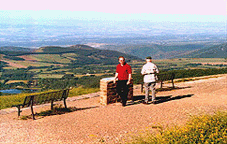 The Pic de Nore
The Pic de NoreFrom up here you have on a clear day a magnificent view of the area. The Pic de Nore with its 1211 meters is the highest top of the Montagne Noire and here also stands the television tower. When the air is crisp and clear, you can even see the snow topped Pyrenees from here!
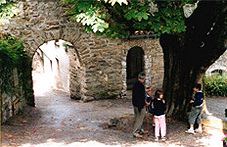 Hautpoul
HautpoulIn the year 413, Ataulphe I, king of the Visigoths, founded Hautpoul. This castle underwent the same destiny as many other castles in the area, it was destroyed by Cathar hunter Simon de Montfort during the crusades against the Cathars. The ones who survived, settled in the plains near the gorge of the Arnette.
Hautpoul, where the remains of the 5th century Visigoth stronghold and the statue of Mary dominate the entire area, is definitely worth a visit. From the remains of the castle you have a good view over the valley of Mazamet.
Many legends tell about the treasure of the Visigoths. The Romans, who sacked Jerusalem, took with them many treasures back to Rome, after which the Visigoths, many centuries later, sacked Rome and took their treasure to the Languedoc.
Hautpoul is one of the places where, according to legend, the treasure of Sion was temporarily hidden.
It is very nice to walk through the ancient streets. The views from the statue of St. Mary are lovely!
Mazamet
Mazamet is, like Carcassonne, a big French provincial town with shops, terraces and sites. In the 16th century, during the Religious Wars, Mazamet was a fortified protestant town, which was plundered and destroyed on 12th August 1628. Today, Mazamet hardly has any old buildings left because of this event, but its main attraction is its location at the foot of the Montagne Noire. Mazamet owes its prosperity to the leather and wool industry, which flourished from the 18th century up until today. In and around Mazamet you will find stores which supply leather and woollen clothes and other articles for an interesting price.
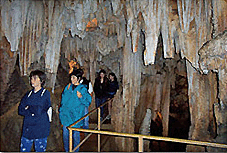 The Limousis Caves
The Limousis CavesThe Caves of Limousis were formed by an underground stream and are of incredible beauty. The caves are now largely dry and one of its main attractions is the "Lustre", a group of white crystals of aragonite. The enormous chandelier has an outline of 10 meters! The 663 meters long caves, which were discovered in 1811, have several rooms. The prehistoric people of the area lived in this and other caves, along with the cave bear. In the course of man's history it also became a place of refuge, for example to the Cathars.
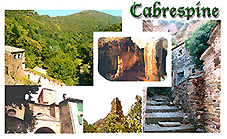 Cabrespine
CabrespineSnuggly situated in the valley of the Clamoux lies Cabrespine. You pass it on your way up to the Pic de Nore from Villeneuve-Minervois. This is an ancient place. The remains of its 13th century castle lie high above the town. Many villages, churches, chapels and castles in the Montagne Noire were built in the 12th and 13th century. In this period, many people fled the wars between the catholic army and the Cathar inhabitants and came here to rebuild their lives. In the mountains one could hide in the thick forests and secret caves, whenever there would be a threat. These Cathars were people who followed a different track of Christianity than the dogmatic catholic church prescribed. For this reason alone they were persecuted and murdered by the armies of the pope. Pope John Paul II has, however, publicly apologized for this grave mistake of the church against peace loving people. After all, a million people died an awful death in the ca. two centuries of Cathar (Albigensian) crusades.
During this period, the castle of Cabrespine was the subject of a judicial lawsuit between Simon de Montfort and Guillaume, the abbot of Lagrasse. De Montfort had gained possession of the castle after the successful siege, and he had also of many other castles which he had taken during his war against the 'heretics'. Judge Thédise, however, returned the town of Cabrespine and its castle to the abbot and indemnified De Montfort otherwise in August 1215. It is likely that, because of the vicinity of the famous castles of Lastours, the castle of Cabrespine has known no other activity during the crusades. The remains are difficult to access and visiting the chateau is at one's own risk.
It is a small adventure to walk through Cabrespine. The narrow, winding streets take the visitor up to medieval uninhabited buildings, and there are lovely views over the valley of the Clamoux. From the Place de l'Eglise you can enjoy pleasant walks through the area. The only café (Ch'Timi) is situated on the main road. Here you can sit on its small terrace and enjoy a cool drink. On the opposite is a little fruit stall. When you reach the banks of the river Clamoux, you will see a fishing place where you can rent fishing gear during the season. Another building houses an invisible restaurant, where on appointment, one can have a pleasant home cooked meal.
On the other side of the Clamoux, opposite of the fishing place, there is an old street which leads to the rocks above. It is called Impasse de la Parfait, the street of the Perfecta, a woman Cathar priestess. She was probably hiding in one of the many caves of the area.
In the 18th century the Neo-Gothic church was built, replacing an older church. Inside you can see lovely sculpture. Apart from the town's charm and the lovely nature walks one can make from the church square, Cabrespine's most important attraction is the famous Gouffre de Cabrespine, a Giant Cave which is also uniquely accessible for wheelchairs.
Gouffre de Cabrespine
You only have to follow the signs from all over the area around Carcassonne to find Cabrespine. It is enthusiastically promoted and it should be. This gorge is the top part of a subterranean system of corridors, eroded by the river Clamoux. Due to its enormous size, one can safely speak of a Giants Gorge. The rock formations exist from run out calcite masses, which have been coloured by minerals. Besides the well known stalagmites and stalactites you can also admire curtains of aragonite. The cave's temperature is constant and only about 15 degrees Celsius, so when you visit in high Summer, bring a sweater or a coat or a vest. You are allowed to take photos and video. The parking is free of charge and you can also sit down and have a drink and a snack. There is a lovely souvenir shop and a tourist information point. The caves are closed between 12.00 and 14.00 hours.
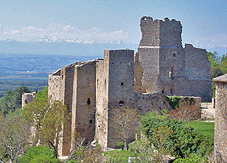 Saissac
SaissacThis medieval town has a feudal castle and a folk museum. This museum is open in July and August and during the French school holidays. It is also open on appointment in the other months. You can stroll around the old streets of Saissac towards the remains of the castle, which are well worth a visit. In 960, this was the site of a big Carolinian stronghold. In the 11th century, the family who owned the castle was one of the most important in the Montagne Noire. The Lord of the castle, who was subordinated to the Count of Carcassonne, strengthened the fortifications around in this period. In the 12th century there were many conflicts between the Lords of Toulouse and Barcelona on who should rule the Midi. In this particular period many towns, castles and cities were fortified. The Cathars sought protection behind their strong walls. Also Saissac supported the Cathars. The well known troubadour Peire Vidal was a much seen guest at the castle of Saissac. During the crusades against the Cathars, all Lords of the Languedoc who protected these people were branded outlaws. Their castles were taken and their possessions became the property of the French crown. French catholic noblemen took profit from this, as their participation in this crusade enabled them to take possession of many castles and pieces of land, being the reward for their input. Jourdain de Saissac succeeded in recapturing his castle for a little while, but after 1242 he had to surrender again. The inhabitants of the Montagne Noire have a weak spot for the Cathars, who, in spite of the inquisition and their goal to crush the Cathars forever, would be able to rebuild their lives again in the villages of the Montagne Noire.
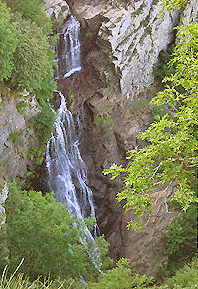 The Falls of Cubserviès
The Falls of CubservièsNot far from Pradelles, in a hidden corner of the Montagne Noire, is a beautiful waterfall, best seen from the tiny village of Cubserviès. This village enjoys its seclusion so much, that the inhabitants took away the road sign. But if you do discover the left turn near the 12th century chapel towards the ancient site, you will enter a land of magic.
People call it 'Terre de Dieu', the Land of God. This would refer to abbey land.
The village is built on the remains of what seem to be an old Visigoth stronghold and on the left hand side from the parking place you will discover the 90 meters high waterfall. Standing here and enjoying the beauty of the area, one must feel indeed to be in the land of God.
Near the entrance road lies a 12th century chapel which reminds the visitor of the importance of the site. Cubserviès or Capservie means 'service to the head', which reminds us of the Templar monks who were believed to have worshipped a head (Baphomet, Baptist, the head of John the Baptist?)....
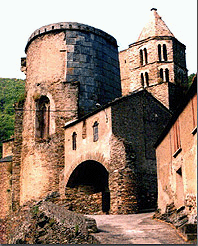 La Tourette
La TouretteNot far from Roquefère lies the pretty Cathar village of La Tourette, like a balcony on the Cabardès. This ancient village still has a few medieval remains, like the Church of St. Anne. This church is part of the old fortress and the site has the character of a well fortified community.
Roquefere
This old village was built around the rock called d'Engalière and is mentioned together with Mas-Cabardès, on the list of 'Prettiest Towns of France'. The town of Roquefère is dominated by the castle, built in 1638 by Francois Cathala from Mas-Cabardès on the remains of a much older castle. Parts of the castle are built in the Louis XIII style. The church was built on a straight rock. A bit further you arrive at the Calvary, where you can take a nice stroll. And finally, Sire de Cabarèt (04-68-263189) is a wonderful address for a delicious local dinner. During the Summer months it is nearly always open from 19.30 hours till late, serving delicacies from the Montagne Noire.
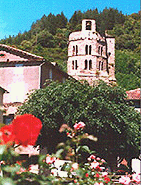 Mas Cabardès
Mas CabardèsThis pittoresk town situated on the banks of the river Orbiel, lies at the foot of the remains of the old castle.
It is lovely to stroll through its old streets.
The Romanesque church with its octagonal tower is one of the nicest of the Cabardès. Another interesting site is the 16th century stone cross with shuttle, which is a reminder of the flourishing textile industry.
'Moulin à papier de Brousses'
In Brousses-et-Villaret stands an old paper mill, in which a museum is situated. Here you will find out all about the history of making paper. The museum is open throughout the year.
St. Papoul
The abbey of St. Papoul was founded in the 12th century. The monastery was built in the 14th century. Apart from these monuments, also the town of St. Papoul is worth a visit.
Montolieu
This little 'village de livre' is well known for its many bookstores. Montolieu is romantically situated at the confluence of the river Dure and Alzau in the Cabardès. There are approximately twenty bookstores and a museum for graphic arts and professions.
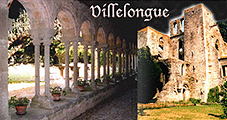 De Abdij van Villelongue
De Abdij van VillelongueThis abbey was originally founded in Compagnes, but it was later moved to Villelongue in the valley of the Vernassonne.
In the 13th century the abbey enjoyed a period of prosperity. Afterwards it was neglected and fell into decay.
Today, the remains of the monastery are a joy to visit.
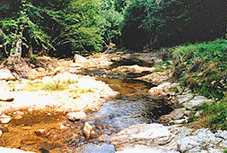 Le Gourp de la Loutre
Le Gourp de la LoutreWhen you follow the river Arnette from Pradelles to Mazamet, you will reach the entrance on the left side of the road after about 15 minutes by car. This is a beautiful picnic spot with a small animal park from where 4 beautiful walks lead into nature. The picnic area lies on the bank of the river Arnette, exactly where it curves on its rocky bed. In the past, a small group of otters lived here, but due to the increasing fishing here, there wasn't enough food for them anymore and they left. The nature walks which leave from the Gourp de la Loutre are 12, 9, 7 and 4 km and travel partially through wet areas, so watertight shoes or boots are preferable.
For more information, visit the Tourist Information Office in Mazamet or Carcassonne. During the Summer holidays, the Maison de Montagne Noire is also opened. This information point is situated on the D118 (Carcassonne-Mazamet).